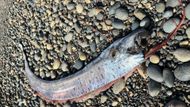Oarfish, scientifically called Regalecus glesne, is considered to be associated with doomsday or, more specifically, earthquakes. This link is grounded in Japanese mythology, for which the oarfish is referred to as “ryugu no tsukai”, which translates to “the messenger from the sea dragon god's palace.”
As per the legend, these fish rise from the seabed to alert people to disasters, including earthquakes and tsunamis. In the past few months, more oarfish have been spotted in California than in the past few years. Reportedly, three oarfish have been found on the coast of California in recent days, with the latest in Encinitas.
Context of doomsday fish
The mythology of oarfish became public in the year 2011 after the occurrence of the Tōhoku earthquake and tsunami in Japan. Before this tragic incident, for months, many oarfish were found washed ashore with many assuming that this was a sign of danger.
Some theories suggest that this species dies due to tectonic activity before an earthquake and is found washed up on shores before an earthquake occurs as suggested by Natural World Facts. Nonetheless, research conducted in 2019 showed that the oarfish had no connection with the occurrence of earthquakes in Japan, as explained by GeoScience.
Recent sightings
The deep-water oarfish was washed ashore at Encinitas in California. This was the third time the state had sighted the species in the past three months. Such events have generally aroused interest and wonder among the public since only 22 oarfish have wrecked on the coast of California since 1901.
Alison Laferriere of the University of California in San Diego's Scripps Institution of Oceanography discovered the 9-foot oarfish on Grandview Beach on November 6. As per Laferriere’s Facebook post, the specimen was retrieved by the National Oceanic and Atmospheric Administration Fisheries Service and was taken to the Southwest Fisheries Science Center.
Ben Frable, manager of the Scripps Oceanography Marine Vertebrate Collection, said in a post:
“We took samples and froze the specimen awaiting further study and final preservation in the Marine Vertebrate Collection. Like with the previous oarfish, this specimen and the samples taken from it will be able to tell us much about the biology, anatomy, genomics, and life history of oarfishes.”
Frable opined that a shift in oceanic conditions, which may be associated with climate variants such as El Niño or La Nina, could be affecting oarfish behavior and hence resulting in an increased number of these fish washing up ashore at coastal regions.
Biological characteristics

Oarfish are extraordinary fishes with elongated bodies that might extend to the length of 36 feet (11 meters). They live in the extreme environment of the ocean where they remain in the range of 200 – 3,300 feet (60 to 1,000 meters) in the mesopelagic zone characterized by low light penetration. Their physical structure and the way they swim like a ribbon are to blame for their presence in marine fables. Oarfish eat small crustaceans and plankton and are not dangerous to humans.
